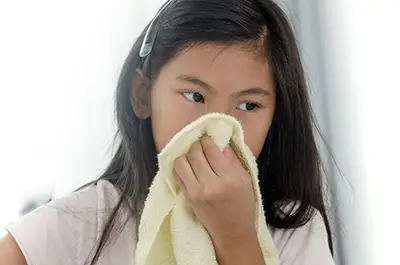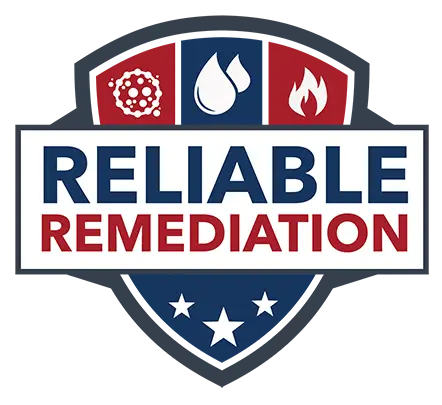Is It Mold or Is It Allergies? Spring Sneezes or Mold Mysteries…
As spring rolls in, it’s easy to get mixed up between mold issues and allergy flare-ups, especially when your eyes are so watery everything looks fuzzy. Figuring out what’s bugging you and tackling it head-on means you can make your home a haven of health and happiness. Whether it’s battling mold or keeping allergies at bay, taking charge early lets you and your family enjoy the springtime splendor without sacrificing your well-being or comfort.

PROBLEM 1
Mold and Allergy Symptoms Often Look Similar
Mold-Related Symptoms:
- Persistent coughing
- Sneezing
- Itchy or watery eyes
- Skin irritation
- Congestion or sinus headaches
- Sneezing
- Runny or stuffy nose
- Itchy or watery eyes
- Fatigue
- Skin rash or hives
PROBLEM 2
It May Not Seem Fair, But the Weather is Out of Your Control
Increased Humidity:
During spring, the combination of melting snow, “April showers”, and rising temperatures can elevate humidity levels both indoors and outdoors. Mold thrives in damp conditions, making it essential to monitor and control humidity levels within your home.
Seasonal Allergies:
Spring is notorious for triggering allergies, and mold spores are a common culprit. Mold releases spores into the air, which can exacerbate allergy symptoms for sensitive individuals. Identifying and addressing mold sources can help reduce allergen exposure.

Mold can grow both indoors and outdoors. Springtime provides an opportunity for outdoor mold to infiltrate homes through open windows, doors, and ventilation systems. Additionally, indoor mold may develop in areas with poor ventilation, such as basements, bathrooms, and kitchens.
PREVENTION AND MANAGEMENT STRATEGIES
Professional Assistance:
- Consult with an allergist for personalized allergy management plans;
- Consider professional mold inspections for hidden issues; and,
- Hire mold remediation experts if mold is identified.
MOLD PREVENTION
- Maintain Proper Ventilation Ensure good air circulation throughout your home by using exhaust fans in bathrooms and kitchens. Open windows on dry and sunny days to promote fresh air flow, reducing the risk of mold growth.
- Monitor Indoor Humidity: Invest in a humidity meter to keep track of indoor humidity levels. Ideally, indoor humidity should be maintained between 30-50%. Use dehumidifiers in damp areas to prevent mold from thriving.
- Inspect and Repair Leaks: Regularly inspect your home for water leaks, especially in basements, attics, and crawl spaces. Repair any leaks promptly to prevent water accumulation, a common precursor to mold growth.
- Clean and Maintain Gutters: Clogged gutters can lead to water overflow, creating a conducive environment for mold. Regularly clean and maintain gutters to ensure proper water drainage away from your home’s foundation.
ALLERGY MANAGEMENT
- Keep Windows Closed During High Pollen Seasons: During peak pollen seasons, which often coincide with spring and early summer, keeping your windows closed can be a simple yet effective way to minimize outdoor allergens entering your home. This prevents pollen from settling on surfaces and in the air, reducing your exposure to potential allergens.
- Use Air Purifiers with HEPA Filters: Investing in a high-quality air purifier equipped with a HEPA (High-Efficiency Particulate Air) filter is a proactive step to improve indoor air quality. HEPA filters can capture microscopic particles, including pollen, pet dander, and mold spores. Place the air purifier in commonly used areas or bedrooms to create a cleaner breathing environment.
- Clean and Vacuum Regularly: Regular cleaning is pivotal in managing indoor allergens. Dust, pollen, and other particles accumulate on surfaces and flooring, contributing to allergy symptoms. Use a vacuum cleaner with a HEPA filter to efficiently trap and remove allergens from carpets and rugs. Additionally, dust surfaces regularly with a damp cloth to prevent particles from becoming airborne.
- Wash Bedding and Curtains in Hot Water to Remove Allergens:Bedding and curtains are common harbors for allergens like dust mites and pollen. Washing these items in hot water (at least 130°F or 54°C) helps eliminate allergens effectively. Aim to wash sheets, pillowcases, and curtains regularly, especially during high pollen seasons. Consider using allergen-proof covers for pillows and mattresses to create an additional barrier.
Incorporating these practices into your routine can significantly reduce allergen exposure and create a more comfortable living environment, particularly for individuals with allergies or respiratory sensitivities. Consistency is key, so integrating these habits into your cleaning regimen will contribute to a healthier and allergy-friendly home.

We believe no one deserves to live in fear of their home making them sick – at Reliable we help people find peace of mind by restoring the health and safety of their home after water, fire, and mold damage.



